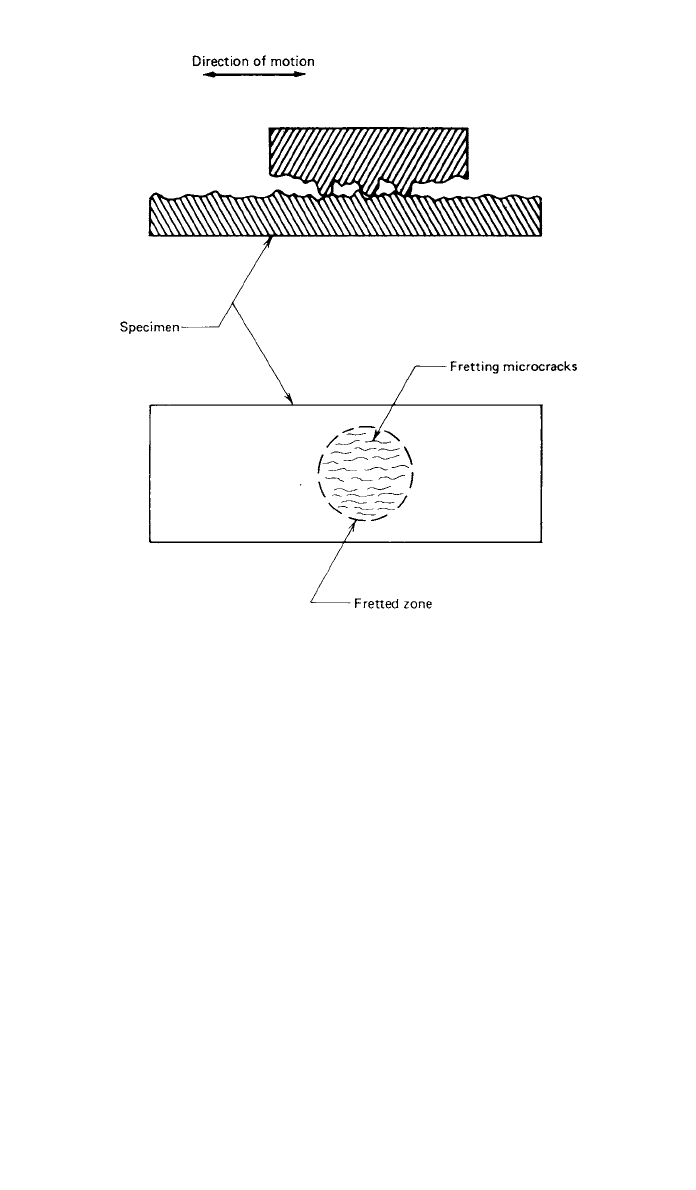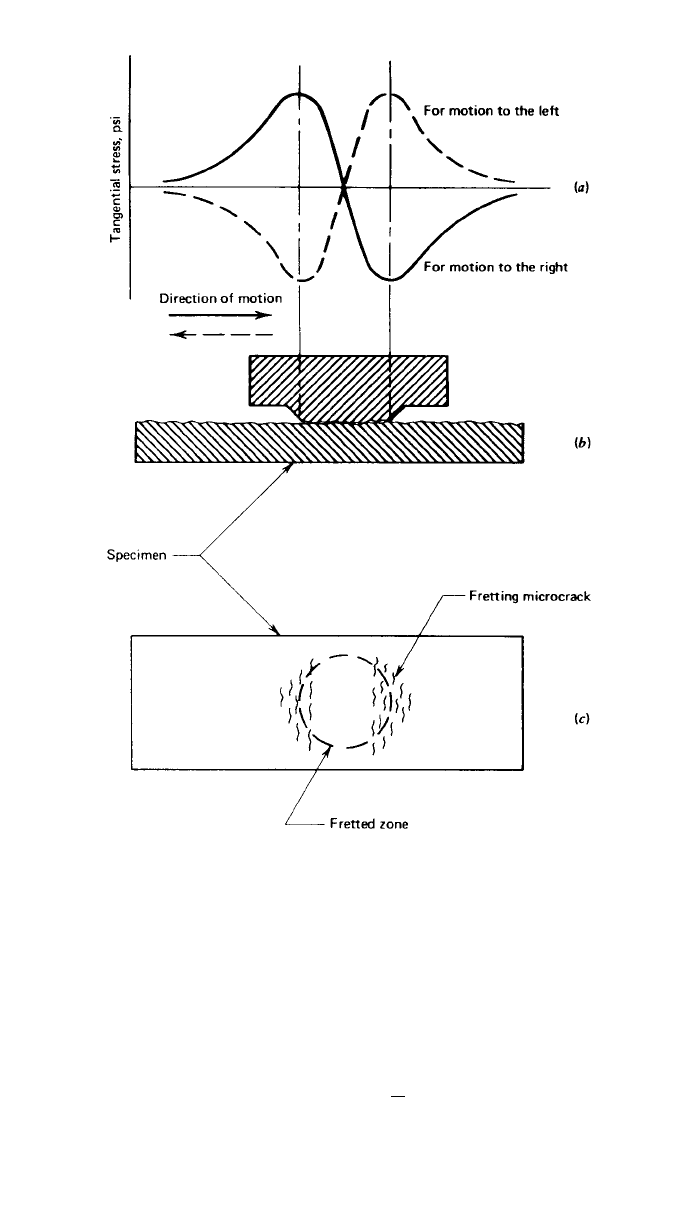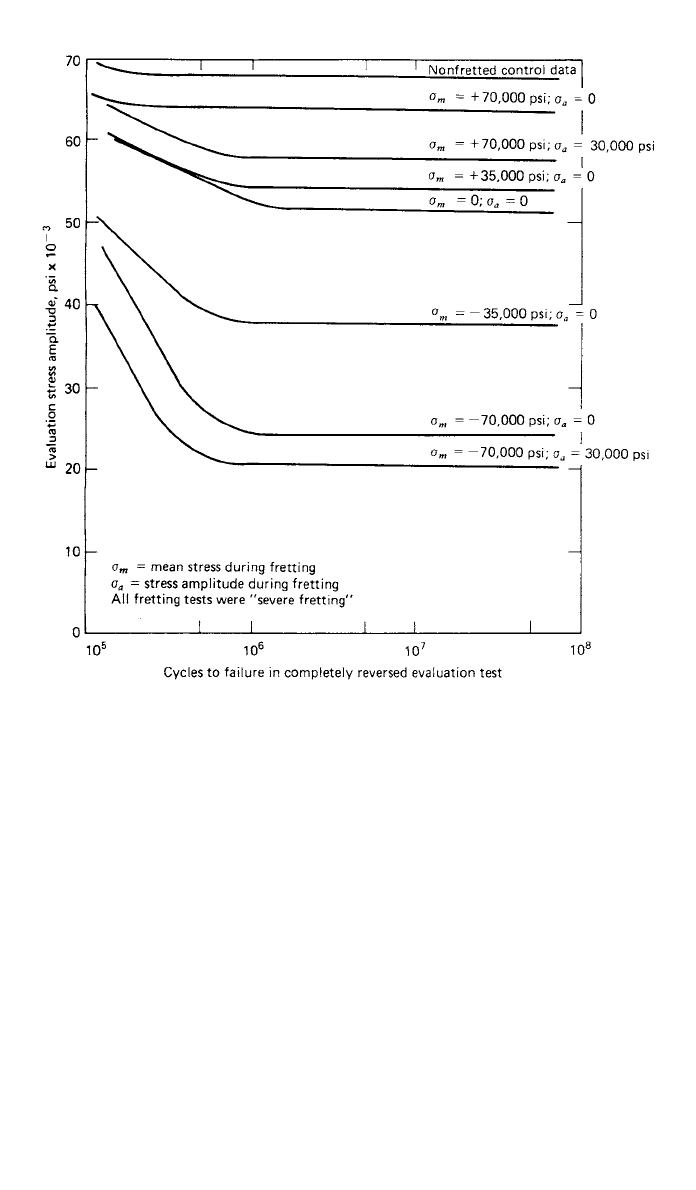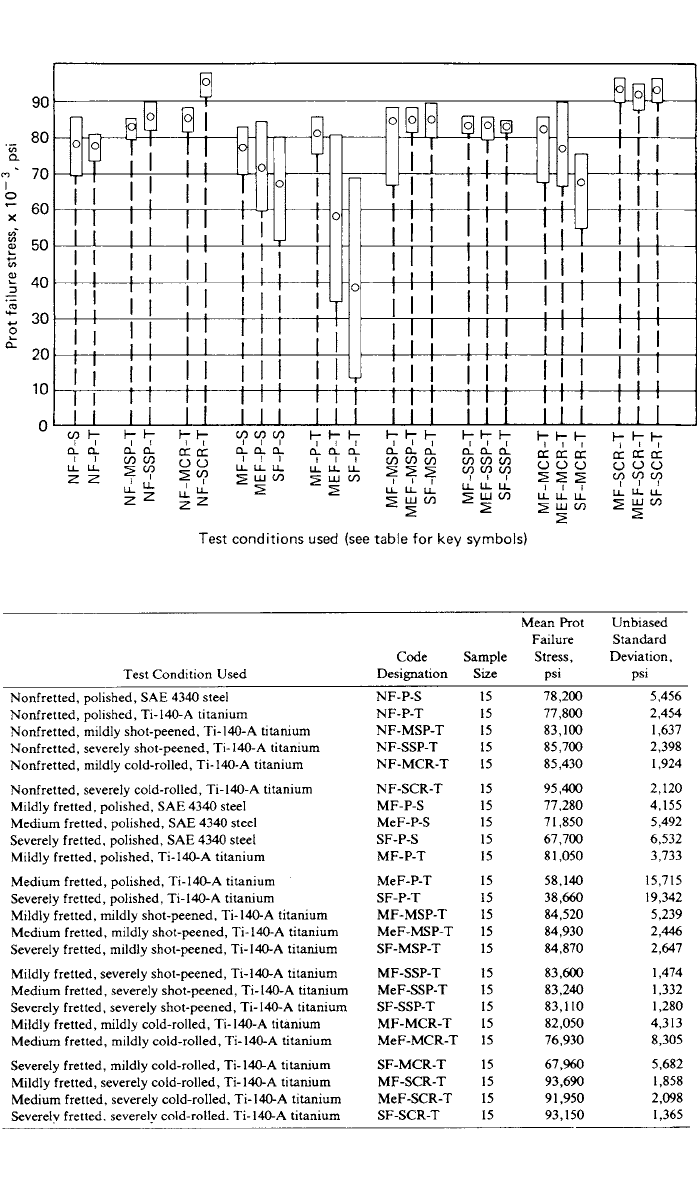Kutz M. Handbook of materials selection
Подождите немного. Документ загружается.


7 FRETTING AND WEAR 749
Fig. 28 Idealized schematic illustration of the stress concentrations produced by
the abrasive pit-digging mechanism.
array of microcracks whose longitudinal axes would be generally perpendicular
to the direction of fretting motion. These cracks would lie in a region adjacent
to the fretting contact zone.
In the delamination theory of fretting
58
it is hypothesized that the combination
of normal and tangential tractive forces transmitted through the asperity-contact
sites at the fretting interface produces a complex multiaxial state of stress,
accompanied by a cycling deformation field, which produces subsurface peak
shearing stress and subsurface crack nucleation sites. With further cycling, the
cracks propagate approximately parallel to the surface, as in the case of the
surface fatigue phenomenon, finally propagating to the surface to produce a thin
wear sheet, which ‘‘delaminates’’ to become a particle of debris.
Supporting evidence has been generated to indicate that under various cir-
cumstances each of the four mechanisms is active and significant in producing
fretting damage.
The influence of the state of stress in the member during the fretting is shown
for several different cases in Fig. 31, including static tensile and compressive
mean stresses during fretting. An interesting observation in Fig. 31 is that fretting
under conditions of compressive mean stress, either static or cyclic, produces a
drastic reduction in fatigue properties. This, at first, does not seem to be in
keeping with the concept that compressive stresses are beneficial in fatigue load-

750 FAILURE MODES
Fig. 29 Idealized schematic illustration of the stress concentrations produced by the
asperity-contact microcrack initiation mechanism.
ing. However, it was deduced
66
that the compressive stresses during fretting
shown in Fig. 31 actually resulted in local residual tensile stresses in the fretted
region. Likewise, the tensile stresses during fretting shown in Fig. 31 actually
resulted in local residual compressive stresses in the fretted region. The conclu-
sion, therefore, is that local compressive stresses are beneficial in minimizing
fretting fatigue damage.
Further evidence of the beneficial effects of compressive residual stresses in
minimizing fretting fatigue damage is illustrated in Fig. 32, where the results of
a series of Prot (fatigue limit) tests are reported for steel and titanium specimens
subjected to various combinations of shot peening and fretting or cold rolling
and fretting. It is clear from these results that the residual compressive stresses
produced by shot peening and cold rolling are effective in minimizing the fretting
damage. The reduction in scatter of the fretted fatigue properties for titanium is
especially important to a designer because design stress is closely related to the
lower limit of the scatter band.
In the final analysis, it is necessary to evaluate the seriousness of fretting
fatigue damage in any specific design by running simulated service tests on
specimens or components. Within the current state-of-the-art knowledge in the
area of fretting fatigue, there is no other safe course of action open to the
designer.
Fretting wear is a change in dimensions through wear directly attributable to
the fretting process between two mating surfaces. It is thought that the abrasive

7 FRETTING AND WEAR 751
Fig. 30 Idealized schematic illustration of the tangential stress components and microcracks
produced by the friction-generated microcrack initiation mechanism.
pit-digging mechanism, the asperity-contact microcrack initiation mechanism,
and the wear-sheet delamination mechanism may all be important in most fret-
ting wear failures. As in the case of fretting fatigue, there has been no good
model developed to describe the fretting wear phenomenon in a way useful for
design. An expression for weight loss due to fretting has been proposed
48
as
C
1/2
W (kL ⫺ kL) ⫹ kSLC (29)
total 0 1 2
F
where W
total
⫽ total specimen weight loss
L
⫽ normal contact load
C
⫽ number of fretting cycles

752 FAILURE MODES
Fig. 31 Residual fatigue properties subsequent to fretting under various states of stress.
F ⫽ frequency of fretting
S
⫽ peak-to-peak slip between fretting surfaces
k
0
, k
1
, k
2
⫽ constants to be empirically determined
This equation has been shown to give relatively good agreement with exper-
imental data over a range of fretting conditions using mild steel specimens.
However, weight loss is not of direct use to a designer. Wear depth is of more
interest. Prediction of wear depth in an actual design application must in general
be based on simulated service testing.
Some investigators have suggested that estimates of fretting wear depth may
be based on the classical adhesive or abrasive wear equations, in which wear
depth is proportional to load and total distance slid, where the total distance slid
is calculated by multiplying relative motion per cycle times number of cycles.
Although there are some supporting data for such a procedure,
67
more investi-
gation is required before it could be recommended as an acceptable approach
for general application.
If fretting wear at a support interface, such as between tubes and support
plates of a steam generator or heat exchanger or between fuel pins and support

7 FRETTING AND WEAR 753
Fig. 32 Fatigue properties of fretted steel and titanium specimens with various degrees of
shot peening and cold rolling. (See Ref. 52.)

754 FAILURE MODES
grids of a reactor core, produces loss of fit at a support site, impact fretting may
occur. Impact fretting is fretting action induced by the small lateral relative
displacements between two surfaces when they impact together, where the small
displacements are caused by Poisson strains or small tangential ‘‘glancing’’ ve-
locity components. Impact fretting has only recently been addressed in the lit-
erature,
68
but it should be noted that under certain circumstances impact fretting
may be a potential failure mode of great importance.
Fretting corrosion may be defined as any corrosive surface involvement re-
sulting as a direct result of fretting action. The consequences of fretting corrosion
are generally much less severe than for either fretting wear or fretting fatigue.
Note that the term fretting corrosion is not being used here as a synonym for
fretting, as in much of the early literature on this topic. Perhaps the most im-
portant single parameter in minimizing fretting corrosion is proper selection of
the material pair for the application. Table 4 lists a variety of material pairs
grouped according to their resistance to fretting corrosion.
69
Cross comparisons
from one investigator’s results to another’s must be made with care because
testing conditions varied widely. The minimization or prevention of fretting dam-
age must be carefully considered as a separate problem in each individual design
application because a palliative in one application may significantly accelerate
fretting damage in a different application. For example, in a joint that is designed
to have no relative motion, it is sometimes possible to reduce or prevent fretting
by increasing the normal pressure until all relative motion is arrested. However,
if the increase in normal pressure does not completely arrest the relative motion,
the result may be significantly increasing fretting damage instead of prevent-
ing it.
Nevertheless, there are several basic principles that are generally effective in
minimizing or preventing fretting. These include:
1. Complete separation of the contacting surfaces.
2. Elimination of all relative motion between the contacting surfaces.
3. If relative motion cannot be eliminated, it is sometimes effective to su-
perpose a large unidirectional relative motion that allows effective lubri-
cation. For example, the practice of driving the inner or outer race of an
oscillatory pivot bearing may be effective in eliminating fretting.
4. Providing compressive residual stresses at the fretting surface; this may
be accomplished by shot peening, cold rolling, or interference fit tech-
niques.
5. Judicious selection of material pairs.
6. Use of interposed low-shear-modulus shim material or plating, such as
lead, rubber, or silver.
7. Use of surface treatments or coatings as solid lubricants.
8. Use of surface grooving or roughening to provide debris escape routes
and differential strain matching through elastic action.
Of all these techniques, only the first two are completely effective in preventing
fretting. The remaining concepts, however, may often be used to minimize fret-
ting damage and yield an acceptable design.

7 FRETTING AND WEAR 755
Table 4 Fretting Corrosion Resistance of Various Material Pairs
69
Material Pairs Having Good Fretting Corrosion Resistance
Sakmann and Rightmire Lead
Silver plate
Silver plate
‘‘Parco-lubrized’’ steel
on Steel
on Steel
on Silver plate
on Steel
Gray and Jenny Grit blasted steel plus lead plate
in. nylon insert
1
––
16
Zinc and iron phosphated
(Bonderizing) steel
on Steel (very good)
on Steel (very good)
on Steel (good with thick coat)
McDowell Laminated plastic
Hardtool steel
Cold-rolled steel
Cast iron
on Gold plate
on Tool steel
on Cold-rolled steel
on Cast iron with phosphate coating
Cast iron
Cast iron
on Cast iron with rubber cement
on Cast iron with tungsten sulfide
coating
Cast iron on Cast iron with rubber insert
Cast iron on Cast iron with Molykote
lubricant
Cast iron on Stainless steel with Molykote
lubricant
Material Pairs Having Intermediate Fretting Corrosion Resistance
Sakmann and Rightmire Cadmium
Zinc
Copper alloy
Zinc
Copper plate
Nickel plate
Silver plate
Iron plate
on Steel
on Steel
on Steel
on Aluminum
on Aluminum
on Aluminum
on Aluminum
on Aluminum
Gray and Jenny Sulfide-coated bronze
Cast bronze
Magnesium
Grit-blasted steel
on Steel
on ‘‘Parco-lubrized’’ steel
on ‘‘Parco-lubrized’’ steel
on Steel
McDowell Cast iron on Cast iron (rough or smooth
surface)
Copper
Brass
Zinc
Cast iron
Cast iron
Magnesium
Zirconium
on Cast iron
on Cast iron
on Cast iron
on Silver plate
on Copper plate
on Copper plate
on Zirconium
Sakmann and Rightmire Steel
Nickel
Aluminum
Al–Si alloy
Antimony plate
Tin
Aluminum
Zinc plate
on Steel
on Steel
no Steel
on Steel
on Steel
on Steel
on Aluminum
on Aluminum
Gray and Jenny Grit blast plus silver plate
Steel
Grit blast plus copper plate
Grit blast plus in plate
Grit blast and aluminum foil
Be–Cu insert
Magnesium
Nitrided steel
on Steel
a
on Steel
on Steel
on Steel
on Steel
on Steel
on Steel
on Chromium-plated steel
b

756 FAILURE MODES
Table 4 (Continued )
Material Pairs Having Poor Fretting Corrosion Resistance
McDowell Aluminum
Aluminum
Magnesium
Cast iron
Laminated plastic
Bakelite
Hard tool steel
Chromium plate
Cast iron
Gold plate
on Cast iron
on Stainless steel
on Cast iron
on Chromium plate
on Cast iron
on Cast iron
on Stainless steel
on Chromium plate
on Tin plate
on Gold plate
a
Possibly effective with light loads and thick (0.005 in.) silver plate.
b
Some improvement by heating chromium plated steel to 538⬚C for 1 hr.
7.2 Wear Phenomena
The complexity of the wear process may be better appreciated by recognizing
that many variables are involved, including the hardness, toughness, ductility,
modulus of elasticity, yield strength, fatigue properties, and structure and com-
position of the mating surfaces, as well as geometry, contact pressure, temper-
ature, state of stress, stress distribution, coefficient of friction, sliding distance,
relative velocity, surface finish, lubricants, contaminants, and ambient atmo-
sphere at the wearing interface. Clearance versus contact-time history of the
wearing surfaces may also be an important factor in some cases. Although the
wear processes are complex, progress has been made toward development of
quantitative empirical relationships for the various subcategories of wear under
specified operating conditions.
Adhesive wear is often characterized as the most basic or fundamental sub-
category of wear since it occurs to some degree whenever two solid surfaces
are in rubbing contact and remains active even when all other modes of wear
have been eliminated. The phenomenon of adhesive wear may be best under-
stood by recalling that all real surfaces, no matter how carefully prepared and
polished, exhibit a general waviness upon which is superposed a distribution of
local protuberances or asperities. As two surfaces are brought into contact, there-
fore, only a relatively few asperities actually touch, and the real area of contact
is only a small fraction of the apparent contact area. (See Chap. 1 of Ref. 44
and Chap. 2 of Ref. 70.) Thus, even under very small applied loads, the local
pressures at the contact sites become high enough to exceed the yield strength
of one or both surfaces, and local plastic flow ensues. If the contacting surfaces
are clean and uncorroded, the very intimate contact generated by this local plas-
tic flow brings the atoms of the two contacting surfaces close enough together
to call into play strong adhesive forces. This process is sometimes called cold
welding. Then if the surfaces are subjected to relative sliding motion, the cold-
welded junctions must be broken. Whether they break at the original interface
or elsewhere within the asperity depends on surface conditions, temperature
distribution, strain-hardening characteristics, local geometry, and stress distri-
bution. If the junction is broken away from the original interface, a particle of
one surface is transferred to the other surface, marking one event in the adhesive
wear process. Later sliding interactions may dislodge the transferred particles as
loose wear particles, or they may remain attached. If this adhesive wear process

7 FRETTING AND WEAR 757
Table 5 Archard Adhesive Wear Constant k for Various
Unlubricated Material Pairs in Sliding Contact
Material Wear Constant k
Zinc on zinc 160 ⫻ 10
⫺
3
Low-carbon steel on low-carbon steel 45 ⫻ 10
⫺
3
Copper on copper 32 ⫻ 10
⫺
3
Stainless steel on stainless steel 21 ⫻ 10
⫺
3
Copper (on low-carbon steel) 1.5 ⫻ 10
⫺
3
Low-carbon steel (on copper) 0.5 ⫻ 10
⫺
3
Bakelite on bakelite 0.02 ⫻ 10
⫺
3
Source: From Ref. 71, with permission of John Wiley & Sons.
Table 6 Order of Magnitude Values for Adhesive Wear Constant k under
Various Conditions of Lubrication
Lubrication Condition
Metal (on Metal)
Like Unlike
Nonmetal
(on Metal)
Unlubricated 5 ⫻ 10
⫺
3
2 ⫻ 10
⫺
4
5 ⫻ 10
⫺
6
Poorly lubricated 2 ⫻ 10
⫺
4
2 ⫻ 10
⫺
2
5 ⫻ 10
⫺
6
Average lubrication 2 ⫻ 10
⫺
5
2 ⫻ 10
⫺
5
5 ⫻ 10
⫺
6
Excellent lubrication 2 ⫻ 10 to 10
⫺
6
⫺
7
2 ⫻ 10 to 10
⫺
6
⫺
7
2 ⫻ 10
⫺
6
Source: From Ref. 71, with permission of John Wiley & Sons.
becomes severe and large-scale metal transfer takes place, the phenomenon is
called galling. If the galling becomes so severe that two surfaces adhere over a
large region so that the actuating forces can no longer produce relative motion
between them, the phenomenon is called seizure. If properly controlled, however,
the adhesive wear rate may be low and self-limiting, often being exploited in
the ‘‘wearing-in’’ process to improve mating surfaces such as bearings or cyl-
inders so that full film lubrication may be effectively used.
One quantitative estimate of the amount of adhesive wear is given as follows
(see Ref. 59 and Chaps. 2 and 6 of Ref. 71):
VkW
adh
d ⫽⫽ L (30)
冉冊冉冊
adh s
A 9
A
a yp a
or
d
⫽ kpL (31)
adh adh ms
where d
adh
is the average wear depth, A
a
is the apparent contact area, L
s
is the
total sliding distance, V
adh
is the wear volume, W is the applied load, p
m
⫽
W/A
a
is the mean nominal contact pressure between bearing surfaces, and k
adh
⫽ k/9
yp
is a wear coefficient that depends on the probability of formation of
a transferred fragment and the yield strength (or hardness) of the softer material.
Typical values of the wear constant k for several material pairs are shown in
Table 5, and the influence of lubrication on the wear constant k is indicated in
Table 6. Noting from (31) that

758 FAILURE MODES
d
adh
k ⫽ (32)
adh
pL
ms
it may be observed that if the ratio d
adh
/p
m
L
s
is experimentally found to be
constant, Eq. (31) should be valid. Experimental evidence has been accumulated
(see pp. 124–125 of Ref. 59) to confirm that for a given material pair this ratio
is constant up to mean nominal contact pressures approximately equal to the
uniaxial yield strength. Above this level the adhesive wear coefficient increases
rapidly, with attendant severe galling and seizure.
In the selection of metal combinations to provide resistance to adhesive wear,
it has been found that the sliding pair should be composed of mutually insoluble
metals and that at least one of the metals should be from the B subgroup of the
periodic table. (See p. 31 of Ref. 72.) The reasons for these observations are
that the number of cold-weld junctions formed is a function of the mutual sol-
ubility, and the strength of the junction bonds is a function of the bonding
characteristics of the metals involved. The metals in the B subgroup of the
periodic table are characterized by weak, brittle covalent bonds. These criteria
have been verified experimentally, as shown in Table 7, where 114 of 123 pairs
tested substantiated the criteria.
In the case of abrasive wear, the wear particles are removed from the surface
by the plowing and gouging action of the asperities of a harder mating surface
or by hard particles trapped between the rubbing surfaces. This type of wear is
manifested by a system of surface grooves and scratches, often called scoring.
The abrasive wear condition in which the hard asperities of one surface wear
away the mating surface is commonly called two-body wear, and the condition
in which hard abrasive particles between the two surfaces cause the wear is
called three-body wear.
An average abrasive wear depth d
abr
may then be estimated as
V (tan
) W
abr m
d ⫽⫽ L (33)
冉冊冉冊
abr s
A 3
A
a yp a
d ⫽ kpL (34)
abr abr ms
where W is total applied load,
is the angle a typical conical asperity makes
with respect to the direction of sliding, (tan
)
m
is a weighted mean value for
all asperities, L
s
is a total distance of sliding,
yp
is the uniaxial yield point
strength for the softer material, V
abr
is abrasive wear volume, p
m
⫽ W/A
a
is the
mean nominal contact pressure between bearing surfaces, and k
abr
⫽ (tan
)
m
/
3
yp
is an abrasive wear coefficient that depends on the roughness character-
istics of the surface and the yield strength (or hardness) of the softer material.
Comparing (33) for abrasive wear volume with (30) for adhesive wear vol-
ume, we note that they are formally the same except the constant k/3 in the
adhesive wear equation is replaced by (tan
)
m
/
in the abrasive wear equation.
Typical values of the wear constant 3(tan
)
m
/
for several materials are shown
in Table 8. As indicated in Table 8, experimental evidence shows that k
abr
for
three-body wear is typically about an order of magnitude smaller than for the
two-body case, probably because the trapped particles tend to roll much of the
time and cut only a small part of the time.
